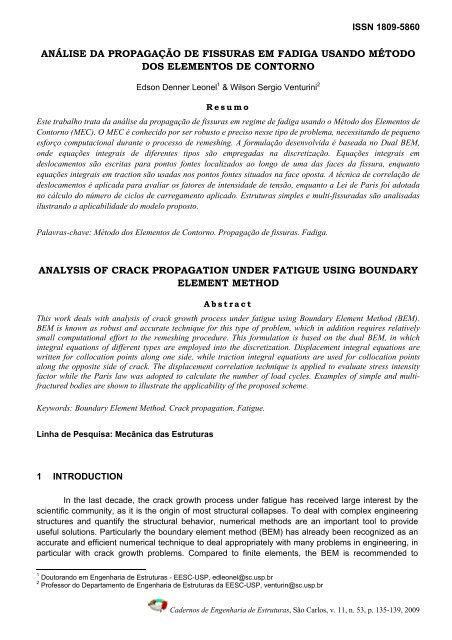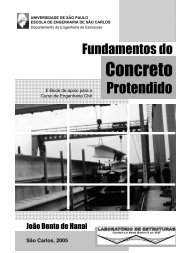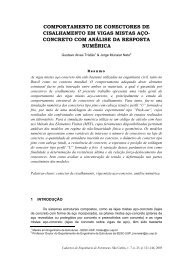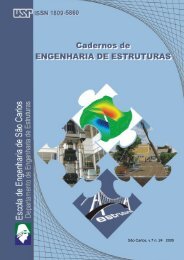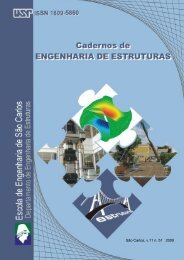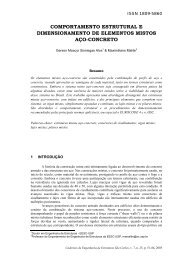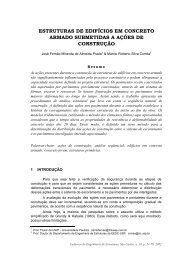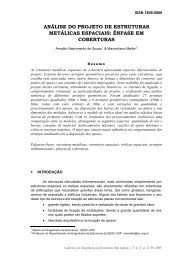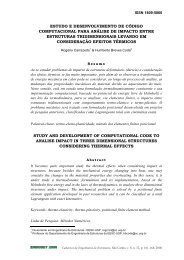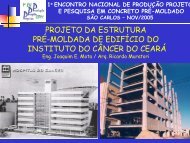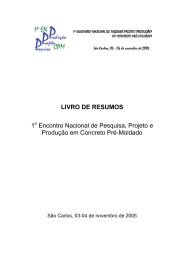download completo - SET - USP
download completo - SET - USP
download completo - SET - USP
Create successful ePaper yourself
Turn your PDF publications into a flip-book with our unique Google optimized e-Paper software.
ISSN 1809-5860<br />
ANÁLISE DA PROPAGAÇÃO DE FISSURAS EM FADIGA USANDO MÉTODO<br />
DOS ELEMENTOS DE CONTORNO<br />
Edson Denner Leonel 1 & Wilson Sergio Venturini 2<br />
Resumo<br />
Este trabalho trata da análise da propagação de fissuras em regime de fadiga usando o Método dos Elementos de<br />
Contorno (MEC). O MEC é conhecido por ser robusto e preciso nesse tipo de problema, necessitando de pequeno<br />
esforço computacional durante o processo de remeshing. A formulação desenvolvida é baseada no Dual BEM,<br />
onde equações integrais de diferentes tipos são empregadas na discretização. Equações integrais em<br />
deslocamentos são escritas para pontos fontes localizados ao longo de uma das faces da fissura, enquanto<br />
equações integrais em traction são usadas nos pontos fontes situados na face oposta. A técnica de correlação de<br />
deslocamentos é aplicada para avaliar os fatores de intensidade de tensão, enquanto a Lei de Paris foi adotada<br />
no cálculo do número de ciclos de carregamento aplicado. Estruturas simples e multi-fissuradas são analisadas<br />
ilustrando a aplicabilidade do modelo proposto.<br />
Palavras-chave: Método dos Elementos de Contorno. Propagação de fissuras. Fadiga.<br />
ANALYSIS OF CRACK PROPAGATION UNDER FATIGUE USING BOUNDARY<br />
ELEMENT METHOD<br />
Abstract<br />
This work deals with analysis of crack growth process under fatigue using Boundary Element Method (BEM).<br />
BEM is known as robust and accurate technique for this type of problem, which in addition requires relatively<br />
small computational effort to the remeshing procedure. This formulation is based on the dual BEM, in which<br />
integral equations of different types are employed into the discretization. Displacement integral equations are<br />
written for collocation points along one side, while traction integral equations are used for collocation points<br />
along the opposite side of crack. The displacement correlation technique is applied to evaluate stress intensity<br />
factor while the Paris law was adopted to calculate the number of load cycles. Examples of simple and multifractured<br />
bodies are shown to illustrate the applicability of the proposed scheme.<br />
Keywords: Boundary Element Method. Crack propagation. Fatigue.<br />
Linha de Pesquisa: Mecânica das Estruturas<br />
1 INTRODUCTION<br />
In the last decade, the crack growth process under fatigue has received large interest by the<br />
scientific community, as it is the origin of most structural collapses. To deal with complex engineering<br />
structures and quantify the structural behavior, numerical methods are an important tool to provide<br />
useful solutions. Particularly the boundary element method (BEM) has already been recognized as an<br />
accurate and efficient numerical technique to deal appropriately with many problems in engineering, in<br />
particular with crack growth problems. Compared to finite elements, the BEM is recommended to<br />
1 Doutorando em Engenharia de Estruturas - EESC-<strong>USP</strong>, edleonel@sc.usp.br<br />
2 Professor do Departamento de Engenharia de Estruturas da EESC-<strong>USP</strong>, venturin@sc.usp.br<br />
Cadernos de Engenharia de Estruturas, São Carlos, v. 11, n. 53, p. 135-139, 2009


